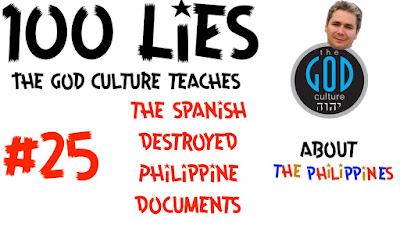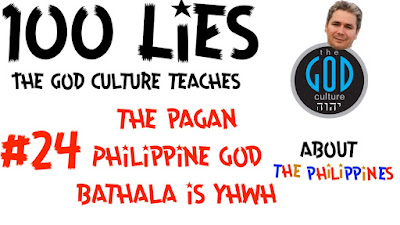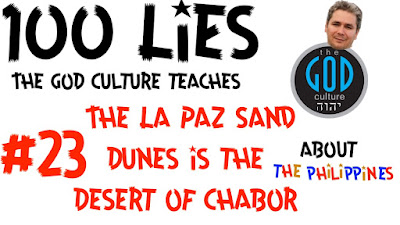Welcome back to 100 lies the God Culture teaches about the Philippines. Today's lie concerns Tim's claim that the Spanish destroyed all Filipino documents relating to their history. As we shall see this is another lie.
In his videos Tim says the following:
|
3:34 We have shared other references in other parts of this series regarding the Spanish friars bragging about all but eradicating the previous history of the Philippines prior to their arrival. Here's one from the American Historical Association of all places from Washington DC saying as much. "The written record of the Philippine Islands starts with the coming of the Spaniards. Not that the country had not had a history and a culture and a literature before, exclamation point, but the Spaniards in their religious zeal destroyed the earlier records as completely as possible therefore much of what is known about pre-Spanish days and there is still much to be uncovered."
This same claim is made in Tim's book The Search for King Solomon's Treasure.
 |
The Search for King Solomon's Treasure, pgs 155 - 157 |
You will notice the history of the Philippines prior to the Spanish seems non-existent in native records. This sparks a debate as to whether Spanish Jesuit friars or the like destroyed the history of the Philippines. Some demand an admission from the Spanish as such which is a false paradigm in expectation. The track is simple to test. When the Spanish arrived, they record a literate people who could read and write. If one can read and write, it means they do so. In areas, Filipinos were a literate people in whole.
Even in the early Spanish occupation, Filipinos are known to be a literate people both reading and writing with their own language.
Notice the significant distinction of the Filipino people in contrast with other Oriental nations. This is affirmed in the Boxer Codex and many times in history. This was a set-apart people who was depicted as wealthier and more literate as one would expect of ancient Ophir. We do not find similar history anywhere else on earth. In applying reason, in the early Spanish days before conquest was even fully recognized, Chirino saw Filipinos writing as well as reading. They wrote something. They read something. Where is it? If insignificant, why destroy it?
That being the case, they wrote something and it is gone and under Spain’s watch, thus the Holy Roman Empire is responsible regardless. They wanted to conquer and control and they also have to accept such responsibility for things which occurred during their reign. One defies logic in assumption that Filipinos would not have written especially the name of their country or area previously for instance and the notion that every writing was pagan is one of the most ridiculous, illogical assumptions one could make. There is no need to produce an admission of guilt by the Spanish to conclude the Spanish destroyed history as they document a literate people and the writings have disappeared during their era of control.
How can anyone peruse these records that the Filipinos wrote things and then, develop a lapse in reason to absolve the Spanish for their erasing history? Filipinos did not wipe out their own history and the Spanish have been caught doing so with the Aztecs and other cultures as an established pattern of behavior. If nothing else, they are guilty of negligence. Even the American Historical Association believes this and remember, the Americans controlled the Philippines after the Spanish.
However, no consensus is required as the documents existed and they are no longer regardless of how they may have disappeared. If hidden by the Filipino people, they would have resurfaced by now. They were taken and likely eradicated.
Everything Tim writes in his book is presumptive bunk. His thesis is that because Filipinos had a script called Baybayin they wrote and preserved their own history. Then the Spanish came along and destroyed all those documents. But this presupposes several things such as Filipinos writing on lasting material like papyrus, paper, or vellum, that these writings were preserved somewhere, and that Filipinos had a sense of history enabling them to write such things down. Tim is very adamant that Filipinos had no architecture. So, if they had no temples or buildings where and how exactly would these writings be preserved from the elements?
Tim has already muddied the waters by saying the Spanish would never admit they destroyed these writings which means Father Pedro Chirino, a man Tim cites, lies when he says the following:
 |
https://babel.hathitrust.org/cgi/pt?id=miun.afk2830.0001.040&view=1up&seq=73&q1=history |
It is not found that these nations had anything written about their religion or about their government, or of their old-time history. All that we have been able to learn has been handed down from father to son in tradition, and is preserved in their customs; and in some songs that they retain in their memory and repeat when they go on the sea, sung to the time of their rowing, and in their merrymakings, feasts, and funerals, and even in their work, when many of them work together. In those songs are recounted the fabulous genealogies and vain deeds of their gods.
Father Chirino says Filipinos did not have any writings about their religion, government, or history. Does that mean Filipinos did not write? Of course not. Father Chirino continues his testimony by noting they wrote on very perishable surfaces like leaves.
https://babel.hathitrust.org/cgi/pt?id=miun.afk2830.0001.012&view=1up&seq=247&q1=writing |
They used to write on reeds and palm-leaves, using as a pen an iron point; now they write their own letters, as well as ours, with a sharpened quill, and, as we do, on paper.
According to Tim we have to reject this testimony that before the Spanish arrived Filipinos wrote only on reeds and palm-leaves and that none of that writing contained a word about their history. But if we have to reject that because the Spanish are lying then there is nothing they wrote that we should believe.
Of course Tim offers no proof that Filipinos wrote history or on paper or vellum and preserved it. Tim offers no eyewitness testimony to the destruction of ancient Filipino documents. In fact, no one can offer such testimony. Not even the American Historical Association. If the Jesuits did destroy Filipino documents what sense would it make for Father Chirino to preserve and explain the Baybayin writing system?
 | |
|
Of course it does not make any sense and Tim does not discuss the fact that the Jesuits preserved Baybayin.
This idea that the Spanish destroyed ancient Filipino documents was described by H. Otley Beyer who wrote the following:
 |
| https://babel.hathitrust.org/cgi/pt?id=uc1.d0001528223&view=1up&seq=311&q1=mexicans |
The fanatic zeal of the Spaniards for the Christian faith and corresponding hatred for all other forms of belief led them to regard the native writings and art as works of the Devil—to be destroyed wherever found. In Mexico and Peru many old records were preserved in more or less modified form in the writings of early native Christians and Spanish half-castes, but in the Philippines the destruction was more ruthlessly thorough and only a few fragments have survived. It cannot be said that such writings did not exist, since the early Filipinos were even more literate than the Mexicans; they used syllabaries of Indian origin. One Spanish priest in southern Luzon boasted of having destroyed more than three hundred scrolls written in the native character.
This alleged fact has no source or basis in reality. Beyer offers no reference for the outlandish claim that one Spanish present in Southern Luzon destroyed more than 300 scrolls. How did they have scrolls if, as Father Chirino testified, they wrote on palm leaves and reeds? According to one scholar Beyer's claims have never been verified.
Many people today, both ordinary Filipinos and some historians not acquainted with the Philippines, are surprised when they learn that the ancient Filipinos actually had a writing system of their own. The complete absence of truly pre-Hispanic specimens of the baybayin script is puzzling and it has lead to a common misconception that fanatical Spanish priests must have burned or otherwise destroyed massive amounts of native documents as they did so ruthlessly in Central America. Even the prominent Dr. H. Otley Beyer wrote in The Philippines before Magellan (1921) that, “one Spanish priest in Southern Luzon boasted of having destroyed more than three hundred scrolls written in the native character.” Historians have searched for the source of Beyer's claim, but until now none have even learned the name of that zealous priest. Furthermore, there has never been a recorded instance of ancient Filipinos writing on scrolls. The fact that they wrote on such perishable materials as leaves and bamboo is probably the reason why no pre-Hispanic documents have survived.
Although many Spaniards didn't hide their disdain for Filipino culture, the only documents they burned were probably the occasional curse or incantation that offended their beliefs. There simply were no “dangerous” documents to burn because the pre-Hispanic Filipinos did not write at length about such things as their own beliefs, mythology, or history. These were the subjects of their oral record, which, indeed, the Spanish priests tried to eradicate through relentless indoctrination. But, in regard to writing, it can be argued that the Spanish friars actually helped to preserve the baybayin by continuing to use it and write about it even after it fell out of use among most Filipinos.
http://paulmorrow.ca/bayeng1.htm
The facts are plain. Filipinos did not write history but transmitted their history orally. The Jesuits did not burn books en masse because there were no books to burn. In fact, the Jesuits preserved the Filipino script Baybayin which wouldn't make any sense if they were out to eradicate Filipino literature. Thus the claim that the Spanish burned Filipino documents is simply one more lie about the Philippines taught by Timothy Jay Schwab of The God Culture.






















.png)




